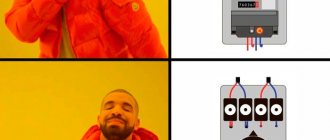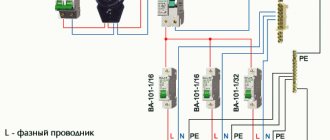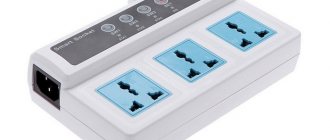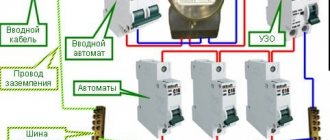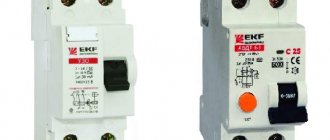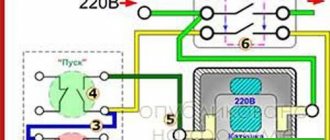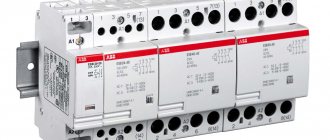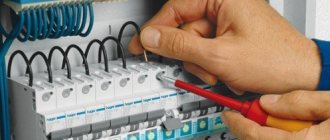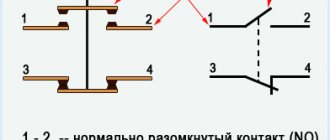“Is it possible to use an automatic machine instead of a switch at the entrance to a private house (before the meter)?” – this question regularly appears on construction forums. And it’s like – why not? After all, both devices actually disconnect the electrical network. Does this mean that they are interchangeable?
No. At all. An engineer who has been involved in wholesale and retail sales of electrical goods for 12 years explained to us why. First, let's look at the purpose of the two devices and their scope of application.
Modular load switch or input circuit breaker? 4 advantages of use.
Surely many of you have used circuit breakers. There were no problems turning the lights on and off using such switches. But you should know that, first of all, circuit breakers were created not for frequent switching operations, but to protect electrical wiring and pantographs from overcurrents.
The role of an ordinary switch, that is, breaking the circuit, is a secondary task of the circuit breaker.
And if you abuse frequent shutdowns using automatic machines, especially without disconnecting the load from the sockets, the contacts inside the automatic machine gradually burn out.
The contacts will eventually burn and blacken, losing their rated capacity. As a result, after some time, you will have to change the circuit breaker. If you do not do this, another short circuit may cause the machine itself to ignite.
Therefore, load switches were developed to improve the safety of electrical panels and the reliability of power supply.
Disadvantages of fuses compared to circuit breakers
It would seem, why fence a garden when machine guns have been invented? After all, fuses have many disadvantages! Here are some:
Difficult to recognize shutdown
If the fuse has “triggered,” there is no way to know - you need to unscrew it and check it visually or with an ohmmeter. Yes, there are fuses with indications of different operating principles, but this is still not convenient. The switched off machine can be seen from afar.
The circuit breaker is turned off in the electrical panel. Try turning it on?
Photo from the article The light went out in the apartment: who is to blame and what to do? Please note that the input circuit breaker (C40) is two-pole. This is exactly what the next section of the article is about:
Zero break problem
If at the entrance to the house there are separate fuses on the phase and neutral (and this used to be the case in all houses), and the zero fuse burns out, the entire load ends up under phase voltage, although in fact nothing works. This happens when the light bulb turns off through the neutral wire, or when the neutral in a single-phase network is broken.
The PUE clearly states that this should not be the case:
PUE 3.1.17. When protecting networks with fuses, the latter must be installed on all normally ungrounded poles or phases. Installation of fuses in neutral working conductors is prohibited .
Despite the ban, this still occurs in old houses where the owners have no money or desire to change anything in their lives:
Meter with traffic jams in a Taganrog burgher apartment
The photo shows not fuses, but their more advanced analogues PAR (automatic threaded fuse), but the meaning is the same, and they are located in the same place.
In modern electrical panels, breaking the zero (neutral wire) is not practiced, but it can only happen in one case - at the input. In this case, the neutral conductor must break simultaneously with the phase conductor (or phase conductors, if there are three of them).
PUE 1.7.145. It is not allowed to connect switching devices in circuits of PE and PEN conductors, except when powering electrical receivers using plug connectors.
It is also allowed to simultaneously disconnect all conductors at the input to electrical installations of individual residential, country and garden houses and similar objects fed by single-phase branches from overhead lines. In this case, the division of the PEN conductor into PE and N conductors must be carried out before the input protective switching device.
There is an inaccuracy in the text of the PUE - “ disconnection of all conductors” . But in the TN-S system there can be 3 or 5 conductors at the input, depending on the number of phases. But the PE protective conductor cannot be torn under any circumstances! Of course, only if a plug connection is not used. I also write about this in an article about types of grounding.
“Allowed” means “if you want, then you can.” For example, it can be convenient to connect the wires of the input cable to the terminals of the input machine, rather than pulling N to a separate bus. In addition, there is greater safety, because the machine will turn off the power not only if there is an overload on the phase conductor, but also on the neutral one (although these currents must be equal). And foolproofing wouldn’t hurt – some craftsmen can’t distinguish zero from phase(
The same thing, but in different words, is said elsewhere:
PUE 3.1.18. ... Releases can be installed in neutral conductors only on the condition that when they are triggered, all energized conductors are simultaneously disconnected from the network.
For the technical implementation of simultaneous breaking of all conductors, a two-pole circuit breaker is used in the case of a single-phase network (photo above), and a four-pole circuit breaker in the case of a three-phase network.
Problem with phase loss in a three-phase network
We have discussed how bad it is to install a fuse in a neutral conductor. In a single-phase circuit this is dangerous, but in a three-phase circuit it leads to phase imbalance and electrical breakdowns (link was above). When an asynchronous motor operates in a three-phase network, due to phase imbalance, the current in the remaining phases increases, and the motor sharply loses power and overheats.
To insure against this, you need to install and correctly configure a thermal relay and/or motor protection circuit breaker. A good addition is a phase control relay. It controls the voltage level, alternation and phase loss. Here is an example of how I installed a phase control relay in a screw compressor after it was damaged by turning it on in the other direction.
So here it is. If the fuse on one phase trips for some reason, this can lead to bad consequences if the protection that I mentioned in the paragraph above is not provided. If there is a circuit breaker instead of a fuse, it will cut off all three phases anyway.
Of course, a phase failure can be caused not only by an overload and a fuse, but the fact remains that in old machines, in which only input fuses remained as protection, the motors burned like candles.
Difficulties with prompt replacement and disconnection of the fuse
Replacing a fuse is a matter of one minute. But this is if you have experience and there is a fuse itself. But as life shows, “a good thought comes later,” and a blown fuse can leave a household without electricity for a long time. But your favorite series doesn’t wait!
Now this, when there are machine guns everywhere, is a memory from childhood. Walked up, turned it on, voila.
The same applies if it is necessary to turn off the circuit using a fuse. If turning off the machine is a matter of seconds, then for “screw” plug fuses it is not only long, but also dangerous. There is also a danger in switching overvoltages - if you unscrew it slowly and under load, sparking will occur up to an arc, which will lead to burning of contacts, interference and damage to the sensitive load.
Before my eyes, in my first year at university, the power supply of the Mazovia computer (produced in the 1980s) burned out like this - they simply gently pulled the fuse out of it when it was turned on.
For knife fuses, breaking the chain is even more dangerous, and this also requires a special handle for removal.
To be fair, turning off the circuit using fuses is done only in emergency situations. And for automatic machines this is a standard function.
Safety
When a household fuse is unscrewed, phase voltage remains on its holder. It’s good if the requirement of the PUE is met:
PUE 3.1.6. Automatic switches and plug-type fuses must be connected to the network so that when the fuse plug (circuit breaker) is unscrewed, the screw sleeve of the fuse (circuit breaker) remains without voltage.
With a circuit breaker everything is much safer. This is especially clearly seen in the example of industrial three-phase switchboards:
PN-2 fuses in one of the plant switchgears
Fuses of three sizes in the switchgear cabinet
All metal parts (except the housing) are live, have a large area, and can be easily touched. And get hit, or arrange a hard short circuit (
Somehow my hand slipped off... The result was that I messed up the hair on my hand, caught a “hare” and melted the pliers.
Another thing is the electrical switchboard based on automatic switches:
Automatic devices in the panel (TN-C system)
To touch live parts, you have to try.
Bugs (jumpers, shunts) instead of fuses
Another minus, located between “online replacement” and “safety”. This is an opportunity to restore the chain without any tools. This is done (you can’t do this!) using any piece of wire or metal. But the fuse didn’t just blow! He saved electrical wiring and housing from fire. If you want to live on a powder keg, install a bug.
Replacing a fuse with a higher rating can also be equated to installing a bug.
What is the reason for installing a bug? Stupidity, short-sightedness, irresponsibility, laziness, haste. Instead of having an arsenal of fuses available or purchasing them when needed.
Yes, there are even special formulas for calculating “bugs” made of wire. But such jumpers are still very dangerous compared to fuses.
Switch ABB OT63F3.
This is the most common ABB switch, which is widely used both in everyday life and in production. Very reliable, can be installed on both DIN rail and mounting panel.
It is sold as a standard 3-pole, but you can either immediately buy a 4-pole OT63F4N2 or buy an additional pole separately and “increase” the switch yourself. Or maybe even two extra ones. click the poles, one on the right, the other on the left, and you get a 5-pole ABB switch)).
This ABB OT63F3 , as the name suggests, is designed for a current of 63 A. In this series of load switches there are switches that are designed for lower currents of 16, 25 and 40 A, but they differ in size and “become” in electrical panels, to put it mildly clumsily, which is clearly visible in the photo borrowed from my famous colleague Cs-Cs.net.
Of course, there are ABB switches of the OT series and higher 63A. ABB produces low-voltage load switches up to 2500 A, but we don’t need them; such loads don’t happen in everyday life.
Perhaps one of the disadvantages of the OT63 switch is its “original” handle, with which it is sold. For me, it is very inconvenient and switching the ABB switch is very inconvenient for her, especially for those who do not have very strong fingers, for example, children and women.
This problem can be solved quite simply; you can buy and install separately a handle of a slightly different design, but very comfortable. Such handles come in two colors: black and red, which, by the way, is also sometimes convenient, so that the tasks of the switches in the shield are clearly understood. For example, an ABB switch with a red handle turns off generator lines, and a black handle turns off ordinary NON-generator lines.
The ABB OT63 switch, as I previously wrote, is very reliable, one might say indestructible and quite practical in the sense that it externally fits into switchboards of all manufacturers, including Schneider Electric and Legrand.
Let's sum it up
As you can see, the question of how to distinguish a robot from an automatic machine externally is complex. The fact is that to simplify interaction, manufacturers make all types of automatic transmissions similar to each other both in modes and in controls in the cabin.
Finally, we note that the use of automatic transmission is becoming very relevant in our time, since automatic transmission is convenient and safe, especially in big cities. However, each type of machine has both pros and cons.
At the same time, the robotic gearbox is not far behind the “classic” automatic gearbox in its popularity. First of all, such demand for manual transmission is due to popularization and cheaper production, which is reflected in the final cost of the car.
What is the difference between a CVT transmission and an automatic transmission or robot transmission: the main differences between CVT and automatic transmission, as well as robotic transmissions such as AMT or DSG.
How to use a robotic gearbox correctly: “single-disc” robot, preselective robotic gearbox with two clutches. Recommendations.
Automatic transmission AT or robotic automated transmission AMT: which gearbox is better, features of “automatic” and “robot”. Recommendations.
What is better to choose, an automatic transmission with a torque converter or a robotic gearbox with one or two clutches. Pros and cons of these types of boxes, recommendations.
What is the difference between a “classic” automatic transmission with a torque converter and a robotic gearbox with one clutch and preselective robots such as DSG.
Robot gearbox: what manual transmissions are there, the strengths and weaknesses of robotic gearboxes. What to consider when purchasing and operating a robot.
Switch ABB SD200.
The SD200 series switches are relatively new, and they began to be produced in 2016. Outwardly, they are almost indistinguishable from the old copy of the E200 series.
But this is only external. Many people know that the E200 series had a design jamb, and therefore they were replaced with a new series.
As the name of the SD200 series suggests, the ABB switch, like the S200 circuit breaker, depending on the last digit, is divided by the number of poles:
- SD201 – single-pole,
- SD202 – two-pole,
- SD203 – three-pole,
- SD204 – four-pole.
The photo also shows an example of a 2-pole switch. Such switches SD201 and SD202 are convenient to use in single-phase switchboards, because they take up less space than OT63, which will take up at least 3 modules.
The ABB SD200 switch is available in rated currents: 16, 25, 32, 40, 50 and 63A. All additional contacts intended for the ABB module are suitable for it.
Conclusion
The switch handle sticking out of the switchboard has become a definite feature of old electrical distribution networks. But recently, switches are used less and less. After all, their main advantage, price, has become less and less important lately.
Automatic machines are more functional, safer, less cumbersome and easy to use, so they are slowly but surely winning places in switchboards from circuit breakers. After all, everywhere you can install a machine instead of a switch, but it is not always possible to install a switch instead of a machine.
Using a switch
Scope of product application:
- transformer booths;
- local step-down substations;
- entrance panels in the entrances of houses;
- industrial equipment in workshops;
- warehouses;
- public places;
- offices, offices and other institutions;
- catering establishments;
- private houses, dachas, cottages.
Before installation, a schematic drawing is made, which indicates the line, consumers and switches. You can use a computer program to make a drawing. A single-phase or three-phase switch is located in a panel that prevents access to it by unauthorized persons.
The main difference between a “machine” and a switch (switch)
A switch, or power disconnector, is a regular switch, only powerful.
Its task is simply to turn off the power on the line. There is virtually nothing in the device circuit except contacts; its design is durable and simple. The design of “automata” is more sophisticated, because functionally it is a more complex device with a larger area of responsibility. Automatic circuit breaker - protects the electrical circuit from overloads and short circuit overcurrents and is designed for a certain number of on-off cycles (depending on the manufacturer, series and model). For example, the wear resistance of the BZMB1-A100 device from Eaton (Moeller) is up to 10,000 cycles.
When there is a need to turn on and off the power grid daily, or even several times a day, using an “automatic machine” is irrational. By manually clicking sensitive equipment like a simple switch, you will exhaust its service life ahead of schedule and for other purposes. After all, the main function of the device is to automatically operate in emergency mode.
It is more logical to install a switch at the input for a simple “on/off”. Moreover, its cost is much lower. So, for a 250A load switch in an online store you will pay from 638 UAH, and for a circuit breaker of this rating, get ready to spend at least 1841 UAH.
Expert tip: It is recommended to use both input devices simultaneously.
For whom which type is best?
If, after reading this article, you are wondering which car with a transmission you should buy, then I will advise you the following:
- Automatic transmission is a good investment. This is a reliable, long-lasting friend of the car. With proper care, it will last more than 150,000 kilometers. DSG will not show such a service life. Moreover, the automatic machine can withstand parking in traffic jams and city traffic. The downside of the machine is the high price of a new box, although contract ones are cheaper, and expensive maintenance. But again, if a person operates the gearbox correctly, changes the oil on time, and does standard repairs, then the automatic transmission will last a long time;
- DSG is smoother when changing gears, consumes little fuel compared to an automatic. However, its resource is limited. If the automatic transmission can be tricked and it will travel for another 100,000 kilometers without additional investments, then the DSG will have to be immediately replaced with a new one or a contract one. DSG does not like idle time in traffic jams, constant speed reductions and speed increases in urban conditions. Therefore, it is better to use a robot when you often travel long distances. Here he shows his best side.
vote
Article rating
How to buy the right ABB switch?
The correct name for switches is switch disconnectors. They are also called load switches. These devices are used to turn on and off the energized supply load. Circuit breakers do not protect a circuit from overload or short circuit and should not be used in place of a circuit breaker. Only with a machine gun. The purpose of the switch is to turn the power on/off. You should not use circuit breakers for this purpose. They have a much smaller switching resource and will quickly fail. In addition, the circuit breaker is designed for protection, so it cannot be taken “with a reserve” of power. But the switch can be taken with any safety margin. This doesn't affect anything.
Pros of fuses
But since fuses are still used today, it means they also have advantages. Many of them outweigh the disadvantages.
Price
Perhaps this is one of the main advantages of fuses. That is why they are used where there are high currents (nominal and short-circuit). An automatic machine with the same parameters will cost much more.
For example, if you need a breaking capacity of more than 25 kA, for the same price you can install fuses with the same parameters as AB, and stock up on fuses for decades to come.
High breaking current
This refers to the rated breaking capacity Icn. Of course, we are talking about devices with completely different operating principles. However, if an AV of the minimum standard size (BA47-29) has a breaking capacity of 6 kA at best, then for blade fuses of the minimum standard size (000) it is 120 kA (at a voltage of 400V), and for cylindrical fuse-links of size 10x38 - 50 kA!
That is why fuses are installed in switchgears and transformer substations where short-circuit currents are high. Simple, cheap and fireproof.
ASU with a meter in the basement of an apartment building
During a short circuit, sparks, smoke and flames do not scatter throughout the entire switchgear, but quietly and imperceptibly remain inside the fuse.
Fuses in ASU - single phase
To justify the machines, I will say that at the specified currents (up to 10 kA), they can continue to operate, but the fuse must be scrapped and replaced.
Single-phase load in a three-phase network
This advantage can be seen in the example of an apartment building. The input is three-phase, but the entire load is single-phase. If each phase is protected by a fuse, if it burns out, the remaining phases will not feel anything. This happens when some of the apartments in the entrance are left “without light”.
An example is the access panel and electrical cabinet of the ASU of the Taganrog factory dormitory. Not to look nervous!
However, in the case of an apartment building and other powerful loads, negative consequences may arise. In particular, due to a break in one of the phases, a phase imbalance will occur, and due to the phase imbalance, a decrease in voltage in the remaining phases and an increase in current in the three-phase neutral wire.
In ideal operating mode (misalignment - 0%), the current in the neutral of a three-phase network is zero. In case of phase imbalance (and a load with low cos φ and high harmonic distortion), the voltage at the neutral terminal (relative to the protective conductor) will be non-zero, and so will the current. If one of the loads breaks, the voltage at the neutral will tend to linear (380 V).
IP protection
The fuse is actually a piece of metal. There are no moving parts or adjustments like circuit breakers. Therefore, it can work in more difficult conditions. It does not need sealed cabinets and clean, dry air. It can work in humidity and dust, in aggressive environments.
Quality assurance
The open secret is that after an open circuit or short circuit there is no way to judge the quality of the machine. We can only hope for the integrity and authority of the manufacturer and believe that the silver coating of the contacts, mechanics and parameters remain the same as in the new machine.
If the fuse blows, we install a new one with the same parameters and calmly enjoy life. That is why they are placed in especially important equipment.
Moreover, the machine does not have a 100% guarantee of operation . Of course, no one will talk about this. But again, an automatic machine is electromechanical. How it works, here is a detailed article with photos. It has a lot of bushings, nuts, springs, levers, etc. And all this can jam, get stuck and break.
And the fuse has a 100% guarantee of operation.
Performance and time-current characteristics
For semiconductor circuits, the speed of protection is very important. I already wrote about this in an article about Connecting and protecting solid-state relays. There are special fast-blow fuses for this purpose. In particular, manufacturers of frequency converters strongly recommend installing fuses at the power input, and not circuit breakers.
The instructions for the Delta VFD-EL frequency generator can be downloaded in my article about installing a frequency converter in a shoe upper polishing machine.
However, there are reservations - it is allowed to install AVs with a “B” type shutdown characteristic, which respond faster in the event of a short circuit. But for this you need to limit the short-circuit current:
Application of fast-blow fuses to protect inverters
The time-current characteristics of fuses are very different from the performance characteristics of circuit breakers. Here is the characteristic of the “KTK-R Class CC Limitron™ fast-acting, rejection-type fuse” fuse, which is described above in the screenshot from the instructions for the frequency converter:
Time-current characteristics of fuses. For several rated currents
As you can see, during a short circuit the fuse uncompromisingly breaks the circuit in milliseconds. This indicates good current limitation of the fuse during a short circuit. For example, a fuse with In=10A burns out in 0.01s at 100A. At the same time, there are fuses with the same rating that operate in the same time at a current of more than 1000A.
Selectivity
Everything is simpler here than with circuit breakers. An article on AV selectivity will come later, but on fuses I will say that for complete selectivity, the ratings of fuses of the same type must differ by at least 1.6 times (for AVs - at least 2.5).
Selectivity of fuses. Selection table
Arc extinction
Everyone saw a flash when the machine was turned off. Despite the fact that it has arc-extinguishing chambers, there is always a spark that can do a disservice in terms of explosion hazard.
In a fuse, the destruction of the circuit occurs easily and imperceptibly, inside the housing. To more thoroughly extinguish the arc energy, quartz sand is used.

